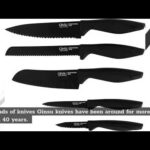Before we talk about Japanese Knife Vs Germany Knife, you need to know that Japan, Switzerland, and Germany have all been influenced by their respective cultures.
For the Japanese, having a perfect tool for a specific purpose is essential. The result is that they have many different knife shapes designed for specific jobs. Germany’s culinary efforts are characterized by versatility and durability.
Knives from Germany excel at many different tasks. The knife’s strengths and weaknesses are unique to each of them. There is no better knife than another. There’s no real right or wrong way to use a knife (if it’s made of high-quality materials, of course). Looking for best Japanese Knives? We have a list of review you can check.
Japanese Knife Vs Germany Knife: The Blade’s Steel
In addition to its sophisticated simplicity, the typical Japanese knife is well known for its unparalleled sharpness. Since these knives were directly descended from samurai swords, cutting only requires a slight graze to complete the cutting process. Steel used for blade cores is very hard, which contributes greatly to their sharpness. Japan knives are made with steel which has a high carbon content, resulting in a Rockwell hardness of 50 to 60. As a result, they keep their sharp edges for a longer period of time. Care for a sword with high carbon steel, however, makes it more likely to rust.
Meanwhile, German knives are known for their durability. Germany designed its knives so that they would have a sturdy, sharp edge, be durable, and be easy to care for. The core of these knives and the surrounding areas are made from softer steel. The technique will reduce the chances of them chipping, breaking, and rusting. Since the steel is softer, they will not hold an edge as sharp as Japanese knives, so you will have to sharpen them more frequently. Ease of care often comes at a cost in terms of edge retention.
Japanese Knife Vs Germany Knife: The Cutting Edge
Let’s start by explaining what we mean when we speak about knives and their cutting edges. It is also referred to as the “bevel.” Most knives have a bevel on both sides, but some traditional Japanese knives have only one, or even differently sized bevels. A knife like this will either be suitable for a right-hander or a left-hander, depending on which side the single bevel is on. As a rule of thumb, when knives have a traditional bevel and a 10 degree angle, it means both sides, making the total angle 20 degrees.
A Japanese knife has a smaller bevel than a German knife, making the blade much sharper. Double-bevelled Japanese knives are available as well as single-bevelled Japanese knives. Regardless of the angle of a Japanese knife’s bevel, it is smaller than that of a German knife. Bevels are typically between seven and eight degrees in Japanese knives. This allows for the precise cutting of foods, like raw fish (sujihiki/yanagiba knives), without damaging the cells, which preserves the taste and texture. Thanks to the hardness of the steel used by Japanese blacksmiths, they can create this angle. Japan values precision, and its knives are angled so that they can achieve it.
However, German knives are typically sharpened to about 10 degrees, which makes them not as sharp as a Japanese knife. With their wider bevel, they compensate for the sharpness by being versatile and better weighted. Cutting through tough objects may not be possible with them.
Japanese Knife Vs Germany Knife: The Weight of the Knife
The Japanese are not known for their strength culturally. They relied on battle technique and the sharpness of their samurai swords in battle to defeat their opponents with the least amount of force necessary. All of the actions required to be exact and swift. In the kitchen, they use a similar method. They can cut through anything without putting force behind the blade by forming a sharp cutting edge on their blades.
German knives are typically heavier. While they don’t have the razor-sharp edges that Japanese cutlery is famed for, they make use of the knife’s weight to do the work for them. This is why cooks who are accustomed to using German blades prefer to use heavier knives.
Was this helpful?
Hi there! I’m a food enthusiast and journalist, and I have a real passion for food that goes beyond the kitchen. I love my dream job and I’m lucky enough to be able to share my knowledge with readers of several large media outlets. My specialty is writing engaging food-related content, and I take pride in being able to connect with my audience. I’m known for my creativity in the kitchen, and I’m confident that I can be the perfect guide for anyone looking to take their culinary journey to the next level.








